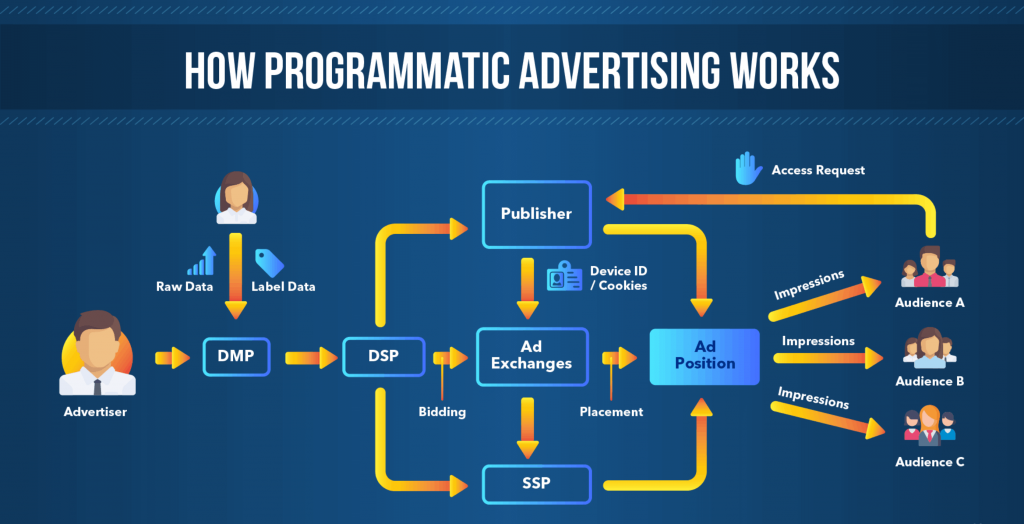
Picture a Grand Rapids coffee shop owner running Facebook ads at 10 a.m. on a Tuesday. She doesn’t know that a snowstorm will push workers to remote status tomorrow, or that her target customers will binge-scroll Instagram during the noon slump. But her ad platform’s AI bidding engine does—or at least it can if she lets it. Here’s how programmatic marketing, powered by machine learning, is turning guess-and-check ad spend into a precision instrument.
The Shift from Manual to Machine
Five years ago, campaign managers lived inside spreadsheets: adjusting bids by pennies, pausing keywords after lunch breaks, and praying they’d guessed right on audience segments. Programmatic advertising flipped that script by sending those decisions to an algorithm. The machine buys ad inventory in milliseconds, reacting to signals humans can’t see—device type, weather, even battery level.
AI: The Secret Sauce
Programmatic alone automates the buy; AI makes the buy smart.
- Real-Time Data Streams
Algorithms ingest cost per click, conversion data, and supply-side inventory faster than any analyst. If mobile engagement jumps 18 percent during a Tigers double-header, the system funnels more budget into mobile placements on the fly. - Predictive Conversion Modeling
Machine-learning models forecast which impressions are most likely to convert. They don’t just use demographics; they factor in micro-behaviors like scroll velocity or dwell time on landing pages. - Budget Autopilot
Instead of allocating $10 per ad set and revisiting it next week, AI shifts dollars minute by minute toward the highest-probability wins, all while respecting your daily cap.
Setting Up for Success
- Clean Data
Garbage in, garbage out. Feed the algorithm accurate conversion events (purchase, signup, form fill) and let it learn quickly. - Granular Pixel Tracking
Install tracking pixels on key steps—cart views, video plays, scroll depth. The richer the signals, the sharper the bidding model. - Flexible Creatives
Supply the machine with multiple headlines, images, and calls to action. Dynamic creative optimization (DCO) mixes and matches pieces to suit each micro-audience.

Common Pitfalls and How to Dodge Them
- Over-Segmentation
Marketers sometimes create so many micro-audiences that the AI can’t gather significant data. Start broader, then let the system subdivide organically. - Budget Shock
Early learning phases can look inefficient. Give the model room (and budget) to explore; it usually finds its footing after 20–50 conversions. - Ignoring Brand Safety
AI seeks cheap impressions. Without genre or site exclusions, your ads might pop up next to questionable content. Set boundaries.
Case Snapshot: Midwest Outdoor Gear
A Kalamazoo-based retailer switched from manual Google Display Network bidding to an AI-driven programmatic DSP. Within six weeks:
- Cost per acquisition dropped 32 percent.
- View-through conversions rose 21 percent—attributed to smarter frequency capping.
- Weekend spend adjusted automatically when rainy forecasts dampened in-store traffic, shifting dollars to e-commerce instead.

Looking Ahead: The Cookieless Horizon
Third-party cookies are on their last legs. AI models that lean on contextual signals—page content, onsite behavior—rather than cookie trails will own the future. Already, some DSPs map anonymized user IDs to probabilistic profiles, ensuring privacy while keeping targeting sharp.
Practical Takeaways
- Marry Creative and Data: Feed the algorithm fresh ad variations weekly; stale creative poisons even the smartest bidding engine.
- Use “Conversion Value” Bidding: Let AI chase revenue, not just raw conversions, so $20-orders don’t get the same weight as $200-orders.
- Monitor, Don’t Micromanage: Check pacing and placements daily, but resist manual overrides unless the machine clearly misunderstands your goals.
Final Word: Programmatic marketing with AI-powered bidding isn’t autopilot; it’s co-pilot. You set the destination—revenue, sign-ups, foot traffic—and the algorithm plots the most efficient flight path. Treat it like a partner, feed it high-quality data, and it will pay you back with lower costs and higher returns—no spreadsheets required.
